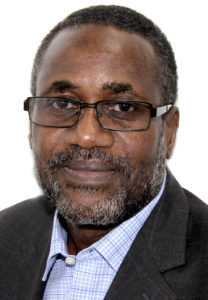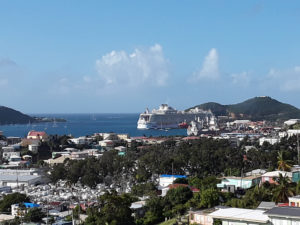This is the second of four stories about the larger structural issues facing the Virgin Islands, with the aim of spurring more public conversation and mobilizing the community around agreed solutions.The first story can be read here.

Development takes place within a particular social and economic context, even though most residents of a place do not understand or acknowledge the existence of that context. The lack of understanding of context is one of the why residents of islands desire and demand economic and social outcomes that are not necessarily compatible with island systems. It may also explain why the development strategies used often do not deliver the expected outcomes.
In the U.S. Virgin Islands, the context is shaped by the fact that:
1 – The territory is a small archipelagic state in the Caribbean.
2 – The territory inherited, and continues to operate, a model of economic development that is designed to facilitate economic growth elsewhere.
3 – The territory is part of a country in which the territory’s relationship with the metropole places the territory in the role of a dependency.
4 – There is a mental model in the U.S. Virgin Islands that operates on the premise that development success is dependent on attracting external (read U.S.) capital and expertise.
So, how does size and location of the U.S. Virgin Islands determine development context and options? Like other small island states, small size means limited natural resources, small populations, and small, often fragmented, vulnerable ecological systems. These factors prevent achievement of economies of scale, placing islands at an economic disadvantage. Physical separation from a large landmass exacerbates that disadvantage in the form of higher transportation costs and a higher level of vulnerability of transportation and communication links.
The unique development challenges faced by small island states led to the establishment of a program of action for Small Island Developing States by the United Nations in 1994. The USVI, as an associate member of the United Nations Economic Commission for Latin America and the Caribbean, can participate directly in the SIDS program.

The location of the USVI in the northeastern Caribbean places it in an area commonly referred to as hurricane alley. Many of the tropical storms traversing the northern Caribbean pass close to or through the USVI. As such, the high level of vulnerability to storms and other weather-related events should be an important consideration in the design of the territory’s economic and development strategies.
The second major factor that shapes development strategies in the USVI is the model of development in operation since the arrival of the Europeans. The USVI was a plantation economy, designed primarily to supply raw materials to a succession of colonial masters. There was little investment in building social infrastructure or human capital that did not support resource extraction, while manufactured goods and other materials needed for the operation of the colony were provided by the colonial power. That model of development established the USVI as a dependency, enriching the colonial countries at the expense of the USVI. The plantation economy existed right up to the time of the U.S. purchase of the USVI from Denmark.
The third factor that determines the context within which development takes place in the USVI is the relationship between the USVI and the United States of America. When the USVI was purchased by the U.S. from Denmark in 1917 the territory was first classified as a possession. Through subsequent legislative acts, the USVI was re-classified as an unincorporated U.S. territory and the people in the USVI were granted U.S. citizenship. However, as an unincorporated territory, not all the constitutional rights of the U.S. were automatically available to residents of the USVI. Fundamental human rights applied, but selected constitutional rights depended on congressional acts and judicial rulings.
There is no question that the transfer of the USVI from Denmark to the U.S. brought investments and improvements that continue to the present day. However, in the absence of some constitutional rights, reforms and improvements take place within a colonial model of governance. The model of dependency is thereby maintained but operates in a country that is an extreme model of capitalism. The convergence of those two paradigms places the USVI in a more vulnerable position.
Several of the factors that perpetuate dependency currently exist in the USVI, including:
– Inadequate investment in people, social infrastructure, and other local assets.
– Real or perceived power imbalances between parts of the territory.
– The net flow of financial capital and human resources from the USVI to the U.S. mainland.
– Internal governance systems that constrain long-term planning and impair effectiveness of public policy delivery systems.
– The application of policies and economic strategies that are not producing the intended development outcomes, or are designed to maintain the hegemony of resident elites.
– The belief that local development success is dependent primarily on external capital and expertise, the mental model that shapes the formulation of development strategies in the USVI.
A mental model is a set of beliefs that shapes the perceptions of a person or group, determining how that person or group behaves in a particular set of circumstances. Awareness of one’s mental model offers the possibility for changes in perception, thinking, and behavior.
The fourth factor that shapes development strategies in the USVI is the shared belief, the mental model, that development outcomes in the metropole are superior to those in the USVI and therefore the strategies used successfully by U.S. states or large metropolitan areas will produce similar outcomes when applied in the USVI. It is a mental model rooted in colonialism, in dependency.
Demonstration of the dependency mental model in operation in the USVI includes the following:
– Periodic expressions of discontent with the relationship with the U.S., the current colonial master, but seeming fondness for, and maintenance of economic and cultural ties with Denmark, the former colonial master.
– Persistence of inadequate investment in social development.
– Periodic policy or legislative acts that undermine mechanisms designed to strengthen the social safety net.
– Constant comparisons of the USVI, not with similar small jurisdictions in the U.S., but instead with large urban centers.
– An apparent lack of trust in the allocation of public resources, resulting in inter-island competition, duplication of executive leadership in the public sector, multiple chambers for the legislature, and duplication of programs even when unnecessary.
– Early attempts in the post-transfer era to diversify the local economy focused on export-oriented industries, tourism and light industry, a focus that continues to the present.
– Periodic expansion of incentive programs and measures to woo large external investors and some service providers without a concomitant strategy for using the revenues and other benefits from the incentive programs to mobilize investment in strategic development initiatives.
Understanding the context within which economic planning takes place should enable the USVI to formulate strategies that address the current economic and fiscal conditions in the territory as well as provide a foundation for long-term sustainable development.
However, a dependency development model does not provide an appropriate framework for pursuing resilience or sustainability objectives, particularly in the context of constant disruptions.
Becoming a resilient community will involve reducing the level of dependency, which means exploring a model of development that makes the USVI more self-sustaining. Certainly it means increasing individual and institutional capability and capacity for public policy formulation and delivery.
Lloyd Gardner is an environmental planning consultant, the principal of Environmental Support Services, LLC and president of the nonprofit, Foundation for Development Planning, Inc. He has been involved in environmental management in the Caribbean since joining the Government of Jamaica in 1982. Since joining the private sector as an environmental planning consultant in 1992, Gardner has provided consulting services to a wide range of regional and international private, intergovernmental, civil society, bilateral and multilateral organizations.






“The net flow of financial capital and human resources from the USVI to the U.S. mainland.”
Net flow of financial capital from the USVI to the U.S. mainland? Are you serious? Give just one significant example of capital flowing FROM the USVI TO the U.S. mainland. What could possibly flow out that is enough to offset the massive financial aid flowing INTO the USVI from the mainland on an annual basis, not even counting the disaster aid? Please educate us, as I have the impression that the only thing going out is misappropriated government funds wired to offshore accounts.